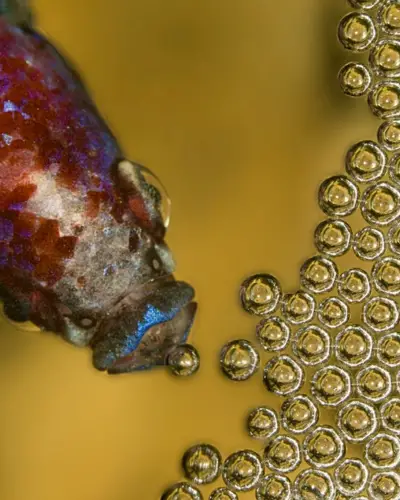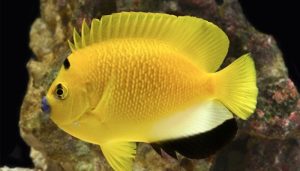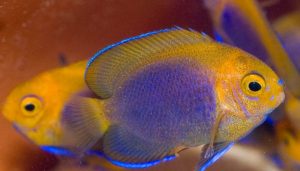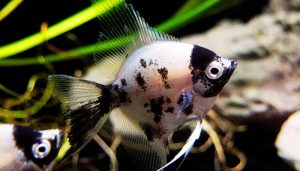Betta nesting bubbles have become a popular addition to many aquariums, as they add visual interest and provide a place for betta fish to create their bubble nests.
However, as with any aquarium accessory, knowing the potential risks and downsides is essential. This article discusses the dark side of betta fish nesting bubbles and the three key risks you should know about before adding them to your aquarium.
Firstly, we’ll be looking at the importance of proper cleaning, as the bubbles can quickly become a breeding environment for dangerous bacteria that can make your fish sick.
Secondly, we’ll discuss the potential risks of improper setup, as poorly placed bubbles can obstruct water flow and deplete oxygen levels, which can be dangerous for your betta fish.

Finally, we’ll examine the potential impact of overuse, as too many bubbles can create an overly stressful environment for your betta.
By understanding these risks and taking the necessary precautions, you can ensure that your betta fish nesting bubbles are visually appealing, safe, and beneficial for your beloved aquatic pets.
So, let’s dive in and explore the dark side of betta nesting bubbles.
Table of Contents
ToggleBetta Nesting Bubbles: What Is It & What Does It Mean?
If you’re a betta fish owner, you may have noticed a cluster of bubbles on the surface of your aquarium. This is known as a betta bubble nest, and it’s a natural behavior for male bettas to create these nests when they feel comfortable and content in their environment.

A betta bubble nest comprises tiny bubbles created by the male betta using his mouth and saliva.
The bubbles then stick together to form a floating nest on the water’s surface. This nest is where the male betta can protect and care for his eggs should he mate with a female betta.
While bubble nests are often associated with beauty and courtship, there are a few risks and concerns related to them.
Three Beta Fish Bubble Nest Potential Risks:
Here are potential floating debris you should be aware of
Poor Water Conditions
One of the primary risks associated with bubble nests is the potential for poor water parameters. Male bettas create these nests by blowing air bubbles and coating them with saliva to make them stick together.
However, in the process, they can introduce oils and proteins from their mouths into the water, which may lead to water pollution. If the bubble nest is not removed or adequately maintained, it can decrease water quality and negatively impact the health of the betta fish.
To relieve this risk, it is crucial to regularly monitor and maintain the water quality in the betta fish tank. Performing partial water changes, using a reliable filtration system, and keeping the tank clean can help prevent the accumulation of pollutants.
Stress and Aggression
Bubble nests can also indicate stress and aggression in male bettas. While it is natural for male bettas to become territorial and aggressive during breeding, excessive anxiety or attack can harm their overall well-being. If a betta fish feels threatened or excessively stressed, betta fish build bubble nests as a sign of distress rather than courtship.
To minimize stress and aggression in betta fish, provide them with an adequately sized tank with plenty of hiding places and spots to explore. Avoid housing multiple male bettas together, as they are highly territorial and prone to aggressive behavior.
Misinterpretation of Health
The presence or absence of bubble nests is not always an accurate indicator of a betta fish’s health. While a well-maintained bubble nest can suggest that the fish is in good condition, the absence of a bubble nest does not necessarily imply poor health or unhappiness.
Some bettas may not build nests even if they are healthy, while others may continuously create bubble nests without a suitable mate.
Instead of solely relying on the presence or quality of a bubble nest, it is essential to consider other aspects of a betta fish’s behavior and overall appearance when assessing its health.
Observe their eating habits, activity level, fin condition, and signs of disease or distress to understand their well-being better.
Why Is My Betta Making a Bubble Nest?
Why do betta nesting bubbles? If you notice your betta building a bubble nest, it’s a sign that they feel comfortable and content in their environment. Male betta fish most commonly create bubble nests, using them as part of their breeding process.
Male bettas create bubble nests to attract females and encourage them to mate. Once a female betta has laid her eggs, the male will gather them and place them in the bubble nest to protect and care for them. The male betta will guard the bubble nest and the eggs until they hatch.
However, it’s signific to note that not all bubble nests are related to breeding behavior. A betta fish who feels comfortable and content in its environment may create a bubble nest simply as a form betta fish to build a cozy resting spot for itself.
It’s also worth noting that female betta fish can sometimes create bubble nests, although this is less common. Female bettas may build bubble nests as a sign of contentment in their environment or as a way to mark their territory.
Are Bubble Nests a Good Sign?
Yes, bubble nests are generally considered a good sign for betta fish. Bubble nests signify that your betta fish feels comfortable and content in their environment.
Male betta fish most commonly create bubble nests, using them as part of their breeding behavior. Male bettas build bubble nests to attract females and encourage them to mate.
Once a female beta has laid her eggs, the male will gather them and place them in the bubble nest to protect and care for them. The male betta will guard the bubble nest and the eggs until they hatch.
However, not all bubble nests are related to breeding behavior. A betta fish who feels comfortable and content in its environment may create a bubble nest simply as a form of self-expression or to build a cozy resting spot for themselves.
Notably, the absence of a bubble nest does not necessarily indicate that your betta fish is unhappy or unhealthy. Some bettas don’t create bubble nests, even if they are healthy and content in their environment.
In summary, bubble nests are generally considered a good sign, but they are not the only indicator of your betta fish’s well-being. Monitoring your betta fish closely is essential to ensure they receive the appropriate care and nutrition they need to thrive.
Why Do Male Bettas Make Bubble Nests?
Male bettas make bubble nests as part of their natural breeding behavior. Bubble nests serve as a way for male bettas to attract females and encourage them to mate.
When a male betta is ready to breed, he will create a bubble nest on the water’s surface. He does this by blowing bubbles and coating them with saliva, which causes the bubbles to stick together. The male will then add bubbles to the nest until it forms a floating mat on the water’s surface.
Once the nest is complete, the male betta will try to attract a female to the nest. He may display colorful fins and swim in a zigzag pattern to catch the female’s attention. If the female is receptive, she will approach the male and spawn with him. The eggs will then be released and fertilized, and the male will gather them up and place them in the bubble nest for protection and care.
While bubble nests are most commonly associated with breeding behavior, male bettas may also create bubble nests as a form of self-expression or to build a cozy resting spot for themselves. However, this behavior is less common and usually unrelated to breeding.
In conclusion, male bettas make bubble nests primarily as part of their natural breeding behavior. By understanding the purpose behind bubble nests, betta fish owners can gain valuable insights into their fish’s behavior and overall well-being.
Should I Remove My Betta’s Bubble Nest?
Removing a betta bubble nest is generally only recommended if it’s causing a problem in your aquarium. If you remove the nest, it can stress out your betta and potentially disrupt their breeding behavior.
However, if the nest obstructs the water flow or causes other issues in your aquarium, you can carefully remove it.
How to Know If My Betta Has Bubble Nest Eggs?
If your male betta has a bubble nest, he may have also laid eggs there. You can tell if eggs are in the nest by looking closely at the bubbles.
These will likely be eggs if you see tiny, white dots inside the bubbles. Male bettas will guard the nest and the eggs, and you may notice them fanning the eggs with their fins to keep them well-oxygenated.
Do Female Bettas Make Bubble Nests?
While it’s less common, female bettas can also make bubble nests. However, this behavior is not related to breeding, as female bettas do not typically lay eggs without the presence of a male betta. Female bettas may create bubble nests as a sign of environmental contentment.
Why Is My Male Betta Making a Bubble Nest Without a Female?
Male bettas may make a bubble nest even without the presence of a female betta. This behavior indicates that the betta feels comfortable and content in their environment.
Male bettas may make bubble nests to mark their territory and show their dominance in the aquarium. They may be preparing for future mating opportunities, even without a female present.
Why Isn’t My Betta Making a Bubble Nest?
If your betta fish isn’t making a bubble nest, it may be due to several reasons. Here are a few possible explanations:
1. Age: Baby bettas may not have developed the instinct to create bubble nests yet, so if your betta is still a juvenile, it may be just a matter of time prior they start making nests.
2. Health: Poor health can also impact a betta’s ability to make bubble nests. If your betta fish is sick or stressed, it may not have the energy or inclination to create a bubble nest.
3. Water quality: Betta fish require clean and well-maintained water to thrive, and poor water quality can negatively impact their overall health and behavior. If the tank water in your aquarium is not adequately filtered or is contaminated with harmful chemicals or pollutants, it could affect your betta’s ability to create bubble nests.
4. Lack of stimulation: Bettas may only create bubble nests if stimulated and engaged in their environment. Providing plenty of hiding spaces, floating plants, and other decorations in the aquarium can help to create a more engaging and stimulating environment for your betta.
5. Genetics: Some bettas don’t create bubble nests, even if they are healthy and content in their environment. This trait may be genetic and related to the individual betta’s personality or temperament.
In summary, there are several possible reasons your betta fish needs to make a bubble nest. By addressing potential issues with age, water temperature, health, water quality, stimulation, and genetics, you can help encourage your betta to create a bubble nest.
If you’re concerned about your betta’s behavior or health, monitoring them closely and seeking veterinary care if necessary is essential. Providing your betta with a clean and engaging environment can help ensure they are happy, healthy, and thriving in their aquarium.
How Can I Help My Betta Make a Bubble Nest?
If you’re interested in helping your betta fish make a bubble nest, there are a few things you can do to encourage this nesting behavior:
Ensure that your betta is healthy:
A healthy betta fish is likelier to engage in natural behaviors like making bubble nests. Ensure that your betta eats a balanced diet, has a clean and well-maintained aquarium environment, and does not show any symptoms of illness or stress.
Create a comfortable environment:
Bettas need a comfortable environment to thrive, including plenty of hiding places, plants, and other decorations. Providing various options for your betta to explore and rest on can help create a more engaging and stimulating environment that encourages natural behaviors like bubble nest-making.
Use a breeding tank:
If you’re interested in breeding your betta fish, using a breeding tank can effectively encourage bubble nest-making. Breeding tanks are designed to provide an ideal environment for betta breeding, with plenty of hiding places and other features that promote natural breeding behaviors.
Add a female betta:
Male bettas are more likely to create bubble nests when a female betta is present. While keeping male and female bettas together in the same tank is not always recommended, introducing a female betta to a breeding tank can be an effective way to encourage bubble nest-making.
Provide plenty of time:
Creating a bubble nest can take time, and it’s essential to be patient and allow your betta fish to develop this behavior at their own pace. Some bettas may start making bubble nests immediately, while others may take more time.
Providing a comfortable and stimulating environment, you can help encourage natural behaviors like bubble nest-making and create a healthy home for your betta fish.
In short, helping your betta fish make a bubble nest requires creating a comfortable and engaging environment, ensuring that your betta is healthy and stress-free, and potentially using a breeding tank or introducing a female betta to encourage natural breeding behaviors.
Your betta fish may start making bubble nests quickly with patience and proper care.
Why Is My Betta Fish Blowing Bubbles and Not Eating?
If your betta fish is blowing bubbles but not eating, it could be a symptom of stress or illness. Blowing bubbles is a natural behavior for bettas, but if they’re doing it excessively or without stopping, it may indicate that something is wrong.
Possible causes include poor water quality, a lack of proper nutrition, or bacterial or fungal infection. Monitoring your betta closely and seeking veterinary care if you see any concerning symptoms is essential.
FAQs
Why do betta fish blow bubbles?
Male betta fish blow bubbles to build bubble nests. These nests hold their eggs and keep them safe until they hatch. It’s a natural part of the breeding process!
Should i remove betta bubble nest?
No, destroying betta bubble nest not recommended, It’s a sign he’s happy and ready to breed. Leave it for him to care for the eggs.
Why does betta blowing bubbles but not eating?
Bubble blowing in bettas is normal, especially for males. It can signal nest building for mating. If your betta isn’t eating for just a day or two, it might be fine. But longer loss of appetite could mean illness. Monitor closely and consult a vet if you’re concerned.
Do bettas make bubble nests when happy?
Betta fish build bubble nests to mate, not necessarily because they’re happy. It’s a sign they’re healthy and mature. Other factors can also trigger nest building.
Final Thoughts
In conclusion, betta nesting bubbles are a fascinating part of betta fish behavior and can provide valuable insight into their health and happiness. While bubble nests are generally a positive sign, it’s essential to understand their possible risks and downsides, such as bacterial growth or poor water quality. If you notice your betta fish creating a bubble nest, it’s a sign that they feel comfortable and content in their environment.
However, ensuring that your aquarium is maintained correctly and that your betta receives the proper nutrition and care they need to thrive is crucial. By understanding the basics of betta nesting bubbles, you can better understand your beta’s behavior and provide them with the best possible care. Whether you’re a seasoned betta fish owner or just starting, learning about betta fish nesting bubbles can help create a happy and healthy aquarium for your beloved betta fish.
You might also like
- Why Do Bettas Make Bubble Nests (5 Surprising Facts)
- 7 Dying Betta Fish Signs – Warning Symptoms You Should Know
- How to Tell If Your Betta Fish Is Unhappy & Why It Matters?
- Why Is My New Betta Fish Hiding and Not Eating? (Solved)
- What Does Betta Fish Poop Look Like? (A Surprising Answer)
- Should I Remove Betta Bubble Nest: Exploring the Pros & Cons
- Betta Fish Bubble Nest with Eggs: 5 Amazing Facts You Didn’t Know
- Can Female Bettas Make Bubble Nests: (You Might Be Surprised)
- 5 Clever Ways to Stop Betta Fish Hides Behind Filter
- Female Betta Destroys Bubble Nest: 3 Main Causes & How to Prevent




